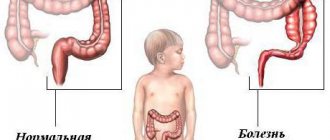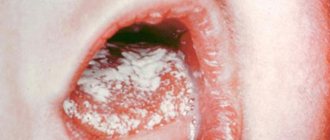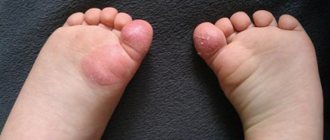Heart defects in children: classification
There are two groups of these diseases: 1. “Blue” - the blood in the body is saturated with carbon dioxide. 2. “White” - blood is depleted of oxygen. The first group of heart defects in children includes: - Pulmonary artery atresia - overgrowth of the lumen; - Tetrado of Fallot - a combination of 4 myocardial anomalies at once: stenosis of the outflow tract of the right ventricle, right ventricular hypertrophy, ventricular septal defect and aortic displacement; — Reversal (transposition) of veins and arteries. The second group of heart defects in children includes: - Atrial septal defect; — Ventricular septal defect. Separate from these two groups are valve defects: - Stenosis or insufficiency of the aortic valve; - Narrowing or excessive dilatation of the tricuspid or mitral valve.
Causes of congenital heart disease
The main leading causes in the formation of defects are most often structural and quantitative chromosomal abnormalities and mutations, i.e. primary genetic factors.
It is also necessary to pay attention to potentially teratogenic environmental factors: various intrauterine infections (rubella viruses, cytomegalovirus, coxsackie, infectious diseases in the mother in the first trimester), medications (vitamin A, antiepileptic drugs, sulfasalazine, trimethoprim), constant contact with toxic substances ( paints, varnishes). In addition, it must be remembered that maternal factors have a negative impact on intrauterine development: reproductive problems preceding a given pregnancy, the presence of diabetes mellitus, phenylketonuria, alcoholism, smoking, age, but also factors from the father - age, drug use ( cocaine, marijuana).
The leading role belongs to the multifactorial theory of the development of congenital heart defects (up to 90%).
Types of congenital heart defects
- Atrial septal defect (ASD) or patent foramen ovale is diagnosed when one or more holes are identified in the interatrial septum. One of the most common congenital heart defects. Depending on the location of the defect, its size, and the strength of blood flow, more or less pronounced clinical signs are determined. ASD is often combined with other cardiac anomalies and is associated with Down syndrome.
- Ventricular septal defect (VSD) is diagnosed when the interventricular septum is underdeveloped at various levels with the formation of a pathological communication between the left and right ventricles. It can occur either alone or together with other developmental anomalies. With a small defect, there is often no pronounced lag in physical development. VSD is dangerous because it can lead to the development of pulmonary hypertension, and therefore must be promptly corrected surgically.
- Coartation of the aorta is a segmental narrowing of the aortic lumen with disruption of normal blood flow from the left ventricle to the systemic circulation. Up to 8% of all cases of congenital heart disease are detected, more often in boys, and are often combined with other anomalies.
- Patent ductus arteriosus is diagnosed when the duct of Batallus is not closed, which is detected in newborns and becomes overgrown in the future. As a result, a partial discharge of arterial blood from the aorta into the pulmonary artery occurs. With this congenital heart disease there are often no severe clinical manifestations, however, the pathology requires surgical correction, since it is associated with a high risk of sudden cardiac death.
- Pulmonary atresia - underdevelopment (full or partial) of the pulmonary valve leaflets with the development of backflow of blood from the pulmonary artery into the cavity of the right ventricle is diagnosed. Subsequently leads to insufficient blood supply to the lungs.
- Pulmonary valve stenosis is an anomaly in which narrowing of the pulmonary valve opening is diagnosed. As a result of pathology, most often of the valve leaflets, normal blood flow from the right ventricle to the pulmonary trunk is disrupted.
- Tetralogy of Fallot is a complex combined congenital heart disorder. Combines ventricular septal defect, pulmonary stenosis, right ventricular hypertrophy, and aortic dextraposition. With this pathology, a mixture of arterial and venous blood occurs.
- Transposition of the great vessels is also a complex congenital disorder. With this pathology, the aorta originates from the right ventricle and carries venous blood, and the pulmonary trunk originates from the left ventricle and carries arterial blood, respectively. Paroxysm is severe and is associated with high mortality in newborns.
- Dextrocardia is an anomaly of intrauterine development characterized by the right-sided placement of the heart. Often, there is a “mirror” arrangement of other unpaired internal organs.
- Ebstein's anomaly is a rare congenital heart defect, diagnosed when the location of the tricuspid valve leaflets changes. Normally - from the atrioventricular fibrous ring, with an anomaly - from the walls of the right ventricle. The right ventricle is smaller, and the right atrium is elongated, including abnormal valves.
Heart disease in newborns
Today, the incidence of heart defects in newborns is 0.8%. Their reasons are as follows: - infection acquired in utero (herpes viruses, influenza, rubella, cytomegavirus infection...); - maternal diseases (diabetes mellitus or metabolic disorders...); - drug abuse during pregnancy; - smoking and alcohol abuse during pregnancy; - genetic predisposition to cardiovascular diseases; — age factor (father over 45 years old, mother over 35 years old); - environmental factor.
Acquired heart defects
A number of diseases cause secondary structural changes in the heart valves. These are vices. What kind of diseases are these:
- systemic pathologies affecting connective tissue - systemic lupus erythematosus, rheumatoid arthritis;
- infective endocarditis;
- atherosclerosis;
- myocardial infarction;
- traumatic heart injuries (including those received during surgery);
- carcinoid syndrome, etc.
Valves are “doors” for the passage of blood from vessels to the heart, from the heart to vessels and between the parts of the heart (atrium and ventricle). Their defects are of two types:
- “under-opening” of doors - stenosis, as a result of which blood cannot freely pass into the corresponding space;
- constantly “open doors” - valve insufficiency, as a result of which blood can pass not only in the forward direction, but also in the opposite direction.
Heart disease in newborns: diagnosis
It must be said that heart defects in newborns can be seen during pregnancy during an ultrasound. Having established heart disease in the fetus, childbirth is then carried out in a special way and, if possible, the baby is operated on immediately after. If a suspicion of a heart defect in a child arose after birth, then the myocardium is examined using electrocardiographic and ultrasound methods, and heart murmurs are detected using phonocardiography. If the collected information is not enough to make an accurate diagnosis, then magnetic nuclear tomography is performed.
How do congenital heart defects manifest?
There are more than a hundred types of the pathology under consideration; the classification of heart defects is quite extensive. For example, blue and white heart defects are distinguished: in the first case, a characteristic sign of pathology will be the cyanosis of the skin, and in the second - their pronounced pallor. Symptoms of problems with the structure of the main organ can appear during intrauterine development; signs of fetal heart defects on ultrasound can become a reason for artificial termination of pregnancy and for providing qualified medical care to an unborn child.
If no abnormalities were identified before the birth of the baby, then in newborns the defect can be diagnosed based on the following symptoms:
- after birth, the child has a pronounced bluish or pale tint to the skin of the face, ears and upper limbs;
- cyanosis of the skin appears when a newborn cries/screams or during feeding;
- The child's extremities are always cold.
When examining a child, the pediatrician may detect a heart murmur, and although this is not a characteristic sign of the pathology in question, additional studies will be carried out to clarify the diagnosis.
Often, immediately after birth, the child develops within normal limits and doctors do not detect any signs of heart problems. This development of the situation is typical for abnormalities in the development of the valve system - symptoms of heart valve disease often appear only by the age of 10:
- shortness of breath appears;
- the child is severely delayed in physical development;
- periodically the skin of the face becomes bluish.
A heart defect in a newborn child can also manifest itself as heart failure - this is a very dangerous condition, which in most cases leads to death.
Heart defects in children: treatment
The method of treating heart defects in a newborn is chosen by a cardiologist. This depends on many factors: the type of defect, its severity, the immune status of the child, which in the first months of his life is repeated by the mother’s status. Conservative methods are used mainly only for general support of the child’s body and his heart muscle in particular. In this case, as a rule, potassium-containing drugs, mild diuretics, sedatives, vitamin complexes and drugs that improve the body's metabolism are prescribed. But in order to finally defeat heart disease in a newborn or a child of several years, there is only one radical method - surgical. If the disease is serious, then the operation is recommended to be performed in the first year of his life (preferably in the first days and even hours). Regardless of the method of treating your child, we strongly recommend that you use Transfer Factor Cardio in complex therapy. From all of the above, it can be understood that the most basic cause of heart defects in children is poor functioning of the immune system (IS) due to various factors. And therefore, along with the treatment of defects, it is necessary to eliminate malfunctions of the child’s immune system. That is why Transferfactor Cardio is the most effective drug for complex therapy of heart diseases. This immunomodulator consists of immune molecules of the same name, which are components of our IS. Once in our body, they perform the following functions: 1. Eliminate all side effects caused by taking various medications and at the same time enhance their healing effect. 2. Bring the child’s immune system to optimal condition. 3. Being the “immune memory” of the body, these particles “remember” information about each foreign element (antigen) that invaded the human body, store this information and when the same antigens re-invade, “transmit” this information to the immune system to neutralize these antigens. And, of course, many are interested in the question: how long do people live with heart disease? Let us tell you right away that with timely surgery, correct and regular treatment of the disease, the prognosis is very favorable. But with advanced defects, the mortality rate is quite high. And therefore, if you value the life and health of your child, don’t wait, start taking care of his health now, contact us, our specialists will definitely help you.
What does ultrasound reveal?
Our clinic uses modern 4D equipment with Doppler mode. With its help, you can obtain an image of 3 main vessels - the superior vena cava, the pulmonary trunk and the ascending aorta. During the examination, not only the location of the vessels is revealed, but also their diameter and other parameters.
The following fetal pathologies will be visible on the monitor screen:
- A decrease in the diameter of the aorta with expansion of the pulmonary trunk can indicate hypoplasia (underdevelopment) of the left parts of the baby’s heart, which are responsible for the onset of blood circulation;
- A decrease in the size of the pulmonary artery trunk while maintaining normal diameters of the aorta and superior vena cava indicates stenosis (narrowing) of the pulmonary artery. In the fetus, only pronounced forms are detected;
- The small diameter of the aorta with a normal 4-chamber structure of the heart is a consequence of coarctation of the aorta (narrowing of the aorta of the heart in a certain segment);
- Visualization of 2 vessels instead of 3 may be a consequence of the connection of the vessels into a common arterial trunk;
- Displacement of the aorta forward or to the right of the pulmonary artery is observed during transposition of the great vessels;
- The diameter of the aorta is expanded, but the diameter of the pulmonary artery is narrowed, and the aorta is displaced forward. This may be tetralogy of Fallot (a very severe combined cardiac anomaly). The problem includes stenosis or hypertrophy of the right ventricular outflow tract, ventricular septal defect, and dextroposition of the aorta (outflow to the right side). Diagnosis of the fetus is extremely difficult, so the Doppler mode comes to the rescue, helping to visualize the flow of blood into the aorta from both ventricles;
- Hypoplasia (underdevelopment) of the right chambers of the heart is determined by a decrease in their size relative to the left chambers. This pathology is usually accompanied by dysplasia (sagging or bulging) of the mitral valve;
- The common atrioventricular canal is seen as a cardiac septal defect with splitting of the atrioventricular valve;
- Hypoplastic syndrome of the left heart is manifested in the form of underdevelopment of the ventricle and mitral and aortic valves;
- A single ventricle is also not normal, because there should be two of them and they are clearly visible in a four-chamber section;
- When the tricuspid valve is underdeveloped, blood from the right atrium does not enter the left atrium, which is clearly visible during Doppler examination;
- From the 2nd trimester, endocardial fibroelastosis is visualized as thickening of the myocardium and worsening of its contraction;
- Underdevelopment of the myocardium of one of the ventricles (Uhl's anomaly) is noticeable in the 2nd trimester.
How to recognize a heart defect in a child and where to treat it
Some complex defects are almost impossible to detect before birth. Often, in appearance, babies with congenital heart disease cannot be distinguished from healthy children - many of them are plump and active. It is also impossible to judge the presence or absence of a disease by heart murmurs. Up to 50% of complex defects do not make any noise.
To screen for the disease, pediatric cardiologists today use special devices - pulse oximeters, which make it possible to assess the degree of oxygen saturation in the blood and see heart rhythms.
If suspicions remain that the child has heart problems, parents need to perform an echocardiogram (ultrasound of the heart) as early as possible (preferably in the first week of the baby’s life). And in order to sleep peacefully, at the same time, also do an ultrasound of the abdominal cavity and neurosonography (ultrasound of the brain).
If, neither during pregnancy nor after birth, the child has no heart problems and no complaints subsequently arise, then standard examinations by a cardiologist and an ECG (before enrollment in kindergarten and school) are sufficient.
Who is at risk?
- premature babies (especially those born before the 32nd week of pregnancy);
- with immunodeficiency;
- with Down syndrome.
During the first six months (and children with congenital heart disease - throughout the entire first year of life) during the dangerous season (from October to May), they must be immunized by injecting a special drug containing antibodies to the virus once a month.
Treatment tactics
If congenital heart disease is detected, the cardiologist will determine further tactics. If the defect is not critical, then the patient will be regularly monitored by doctors. They will prescribe treatment and determine the timing of surgery. If the child is in good health and condition, the cardiologist may allow massage and therapeutic exercises.
In addition, a child with congenital heart disease must be vaccinated (due to reduced blood circulation, infections stick to him).
In addition to vaccinations common to all children, children with congenital heart disease and some other children under 1 year of age need protection against respiratory syncytial virus (RSV infection). For them, this virus can be fatal, as it causes dangerous changes in the lungs, fraught with severe bronchitis and even pneumonia.
Only a small proportion of children with congenital heart disease can be operated on endovascularly (when the surgeon inserts instruments through a vessel, without cutting the chest). In other cases, surgery is performed on an open heart using artificial circulation. This surgery is difficult, but rewarding. After all, 85% of children with congenital heart disease who were operated on in a timely manner successfully survive the 18-year mark and enter adulthood. They get a profession, play sports, start families and have children. While without surgery they would have no chance of life.
Where to treat?
1) MC “Cardio Asia +”, Osh
Medical has been operating since December 21, 2012. The clinic provides high-tech cardiac care, and from 2021, modern neurosurgical care.
The specialists of the Cardio Asia+ MC have a prestigious reputation and are leading experts in their field. They will help to establish the cause of pain in the heart, arrhythmia, arterial hypertension and a number of problems. The main advantage of the company is an individual approach to each client, which allows the company’s employees to correctly diagnose and treat.
"Cardio Asia+"
uses the most innovative methods for diagnosing and treating heart diseases. The clinic is equipped with high-class equipment. In its work, the organization uses only safe and high-quality products from trusted manufacturers. A distinctive feature of the company is the constant support of the patient, which makes it possible to improve well-being and prevent complications and other problems.
2) Research Institute of Heart Surgery (NIIHSTO)
The operations are performed by cardiovascular surgeon Abay Turdubaev and member of the American College of Physicians and the European Association of Cardiologists Roin Rekvava at the Department of X-ray Surgery (NIIHSTO).
The Scientific Research Institute of Heart Surgery and Organ Transplantation (NIIHSTO) is a state medical and preventive, tertiary level health care research organization that provides specialized medical and sanitary care in the field of cardiovascular surgery and organ transplantation and carries out therapeutic, preventive and scientific activities.
3) Southern Regional Scientific Center for Cardiovascular Surgery, Jalal-Abad
The Southern Regional Center for Cardiovascular Surgery in Jalal-Abad was opened in 2011 as a branch of the National Center for Heart Surgery and Organ Transplantation.
Every day, from 2 to 5 patients with acute coronary syndrome or heart attack are received here from the entire region, as well as from the neighboring Osh region and the Leilek district of the Batken region.
It is one of the leaders among medical organizations of the Kyrgyz Republic, providing the population with highly qualified and high-tech cardiac and cardiac surgical care that meets the most advanced achievements of modern medicine in the diagnosis, treatment and rehabilitation of patients with cardiovascular diseases.
4) Cardiac surgery clinic BIKARD Bicard
The Bicard Clinic is equipped with ultra-modern medical equipment from the world's leading manufacturers.
The clinic has implemented a computerized documentation system. The clinic operates around the clock and provides emergency high-tech care regardless of the time of day.
Outpatient and outpatient care is provided to patients in the following specialties: cardiac surgery, cardiology, x-ray surgery.
Diagnostic service - represented by a clinical and biochemical laboratory, which operates within 24 hours and provides the full range of necessary laboratory tests with results in the shortest possible time.
The Department of Radiation and Functional Diagnostics performs all types of ultrasound examinations, Dopplerography, echocardiography, transesophageal echocardiography, treadmill test, Holter ECG, ABPM and X-ray diagnostics.
The clinic has 60 beds and includes two unique, modern operating rooms, cardiac surgery and interventional cardiology, and arrhythmology that meet international standards.
You can get more detailed information on the website www.jurok.kg.
Heart disease. Symptoms
Heart disease. Symptoms in a newborn
Small defects in the structure of the heart may not be detected in the first days and months of life. More significant damage is manifested by the following clinical signs:
- increased or decreased heart rate;
- cyanosis (blue discoloration) of the nasolabial triangle and limbs;
- pallor, sweating and decreased temperature of the feet, palms, and tip of the nose;
- dyspnea;
- frequent regurgitation and difficulty sucking;
- poor weight gain;
- swelling;
- fainting states
- heart murmurs.
Heart disease. Symptoms in a child
An asymptomatic course is typical for minor defects and defects with late manifestation. In other situations, the “set” of clinical signs varies somewhat depending on the type of damage, but some of the most common symptoms can be identified:
- developmental delay (physical);
- shortness of breath during exercise (significant or minor - depends on the severity of the condition);
- cyanosis of the extremities and nasolabial triangle (appearing or worsening during exercise);
- symptom of “drum sticks” and “watch glasses” - characteristic of a number of cardiac, pulmonary, and liver pathologies, thickening of the terminal phalanges of the fingers (sometimes of the toes) and a change in the shape of the nail bed;
- tendency to lung infections;
- arrhythmias;
- chest pain;
- orthopnea (difficulty breathing when lying down);
- swelling of the lower extremities;
- loss of consciousness, etc.
Heart disease. Symptoms in adults
In adults, the congenital defect manifests itself with the signs described above. Especially if the first symptoms appeared after 15–20 years. If the defect was operated on in a timely manner, clinical manifestations may be minor or absent altogether.
Acquired defects behave differently. There are heart defects (for example, mitral stenosis) with very slow progression (the first symptoms that cause concern appear 10 years after diagnosis).
In general, it all depends on the degree of damage to the valve.
The leading symptoms of heart disease in adults are:
- tachycardia and arrhythmias (up to atrial fibrillation);
- chest pain;
- weakness, shortness of breath on exertion and at rest;
- cyanosis of the face and limbs;
- orthopnea;
- attacks of cardiac asthma;
- angina pectoris;
- fainting;
- swelling;
- lung diseases; (up to swelling);
- with right ventricular failure - pain in the right hypochondrium, nausea.
First, characteristic signs of left or right ventricular failure appear (depending on the location of the defect). But over time, doctors are faced with symptoms of both types.








